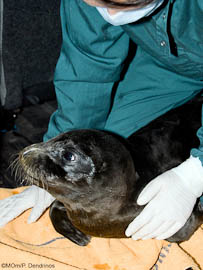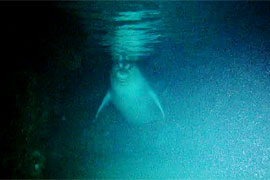 Greek monk seal research and protection NGO MOm, announced today that it had rescued an orphaned Mediterranean monk seal pup on the Aegean island of Evia on 8 October 2010.
Greek monk seal research and protection NGO MOm, announced today that it had rescued an orphaned Mediterranean monk seal pup on the Aegean island of Evia on 8 October 2010.
The pup had been observed struggling in stormy seas and strong winds of 8 Beaufort before emerging onto Pili beach on Evia’s northern coast. Residents contacted the Port Police, who in turn alerted MOm, setting the rescue in operation.
According to MOm’s Rescue Coordinator, Marianna Psaradellis, the male pup, who has been named “Lazarus”, is approximately 10 days old, and is presumed to have been separated from its mother by the storm. Initial diagnosis on site found Lazarus to be suffering from hypothermia, dehydration and exhaustion.

 Simon Nadim, Managing Director of the
Simon Nadim, Managing Director of the  Venerdì 18 giugno lo staff del diving center “Massub” ha avvistato e fotografato, nella zona B dell’Area Marina Protetta (AMP), un esemplare di foca monaca di poco meno di 2 metri di lunghezza. Questa piacevole ed inaspettata notizia avviene proprio nell’anno internazionale della biodiversità; questa visita dimostra come le AMP siano dei veri e propri “santuari naturali” capaci di tutelare la biodiversità attraendo nuovamente specie scomparse. Ormai undici anni di gestione nell’AMP Portofino fanno sì che alcune specie di pesci (come Epinephelus marginatus), che erano pressoché scomparse, siano ora presenti, e in taglie considerevoli; proprio in questo contesto si inserisce la visita della foca monaca che, essendo ghiotta di grossi pesci non reperibili altrove, crediamo sia stata spinta a visitare la nostra AMP.
Venerdì 18 giugno lo staff del diving center “Massub” ha avvistato e fotografato, nella zona B dell’Area Marina Protetta (AMP), un esemplare di foca monaca di poco meno di 2 metri di lunghezza. Questa piacevole ed inaspettata notizia avviene proprio nell’anno internazionale della biodiversità; questa visita dimostra come le AMP siano dei veri e propri “santuari naturali” capaci di tutelare la biodiversità attraendo nuovamente specie scomparse. Ormai undici anni di gestione nell’AMP Portofino fanno sì che alcune specie di pesci (come Epinephelus marginatus), che erano pressoché scomparse, siano ora presenti, e in taglie considerevoli; proprio in questo contesto si inserisce la visita della foca monaca che, essendo ghiotta di grossi pesci non reperibili altrove, crediamo sia stata spinta a visitare la nostra AMP.